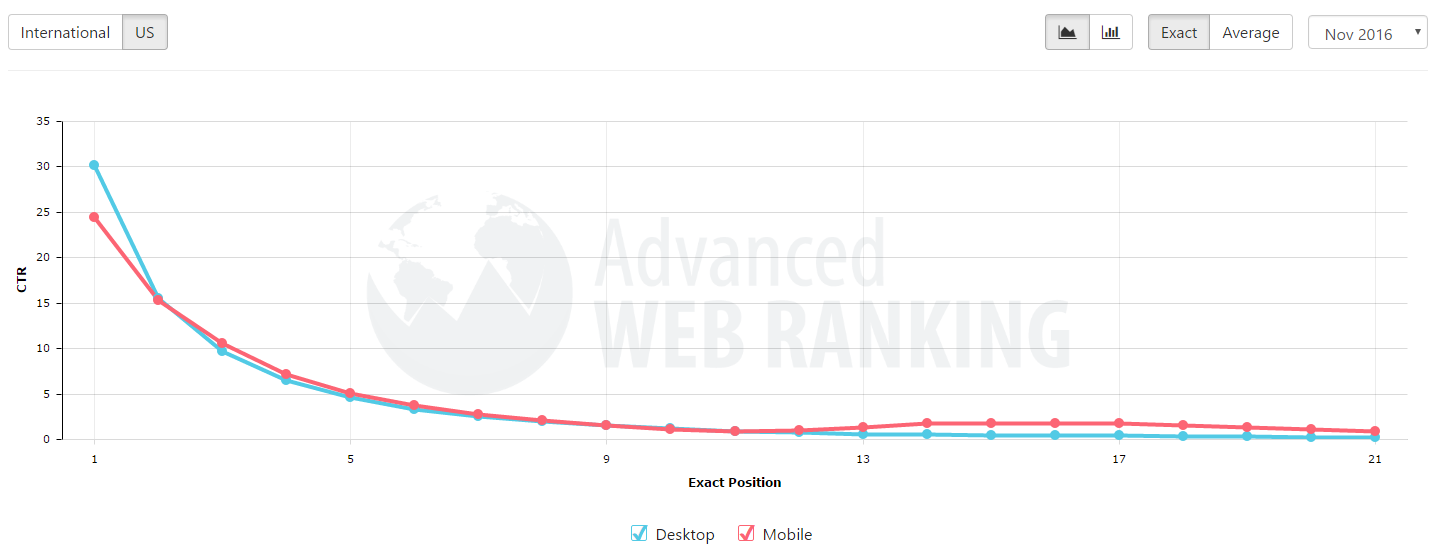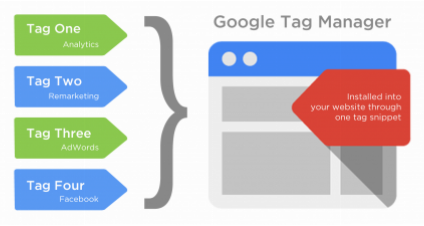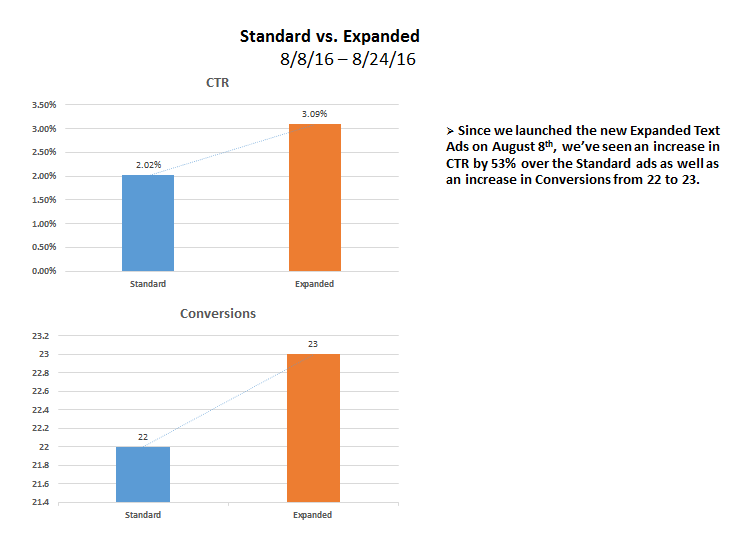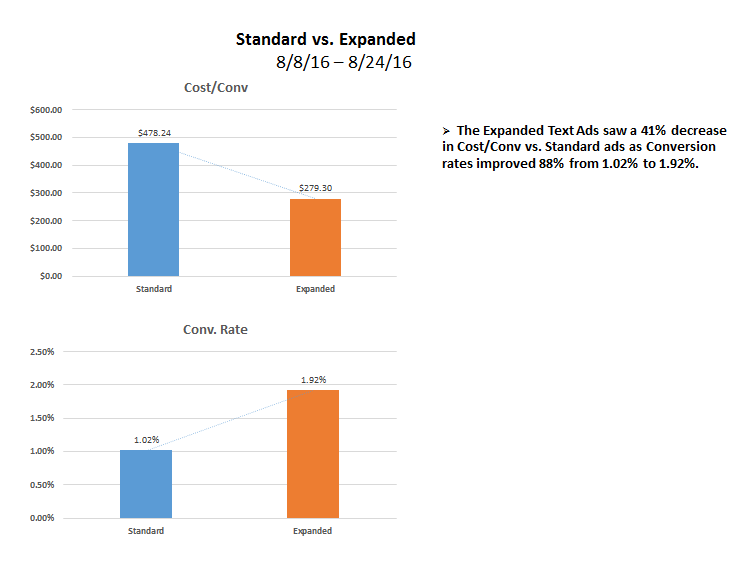by Charles River Interactive | February 2, 2017 | Organic Search
As SEOs, we’re used to Google changing things up on us on the fly. Google’s most recent search algorithm update makes it clear that the way to the top of Page 1 is a total focus on your user and their intent.
SEOs for years have cited industry-standard click-through rates based on the position on a search engine results page (SERP).

Organic click-through rates for searches coming from 1,708,342 keywords for 48,280 websites.
Recently, however, Google increased the number of ads displayed at the top of a SERP. It is now up to SEOs to find a way to maintain organic traffic to our sites as we lose even more real estate on Page 1 SERPs. Here’s how CRI has done just that.
AdWords’ Manifest Destiny Approach to SERPs
Click-through rates—even for the #1 overall position in an organic search—will be lower than previously. Users may not care that they’re clicking on an ad. This is especially true for branded searches, where the user may pause only to make sure the link they’re about to click belongs to the brand they searched.
In effect, we’re dealing with a new normal—where organic as a channel is able to claim a smaller share of the overall traffic mix.
But there is hope! The expanded ad pack is visible on simple keyword searches. A branded search, or a top-of-funnel search, will likely return multiple ads at the top of the SERP. To see organic search results uncolored by the expanded reach of PPC, requires you move down funnel, to the targeted searches typical of a user who’s well into their purchasing decision.
Long-tail keywords: A New Hope
Google encourages SEOs and digital marketers to focus on meeting the information needs and expectations of their users. This focus on search intent has often been yada yada-ed by marketers to read as, “Well you obviously need to start with great content that your users want to engage with.”
Advising our clients to focus only on producing great content would be missing the point. What Google is really telling SEOs with these most recent changes to their SERPs is that a focus on long-tail keywords based on user intent is no longer an option, but a requirement. This leads to a three-step process to ensure your SEO and content strategy are working together to achieve results:
Step 1: Identify high-volume keyword ‘slugs’. Traditional keyword research will continue to play a role in effective SEO. But going forward, identifying and optimizing around high-volume keywords will occur as a byproduct of an increased emphasis on user intent, and won’t be itself an end goal.
Step 2: Understand the problem your product solves. The surest way to incorporate your high-volume keywords into relevant long-tail keyphrases is to contextualize those terms to the problems your potential customers are trying to solve. So, while your desired keyword might be, say, “charity donation”, knowing that donation efficiency is the top consideration for a significant cohort of your donors will help you identify and build out a matrix of relevant long-tail keyphrases that incorporate that keyword ‘slug’.
Step 3: Craft your keyphrase strategy to incorporate your slugs into natural language queries. Knowing your target demographics primary concerns will inform the long-tail keyphrases you target. Continuing the example from Step 2, you might optimize around, say, “best charity to donate to for [x]”, or “most efficient charity to donate to”—queries that give weight to the objections, concerns and interests your target users may hold.
A More Robust Keyphrase Strategy for the New Search Landscape
In recent months, CRI has worked with clients to develop new keyphrase strategies. It might seem like a small bit of semantic gymnastics, but the migration from keywords to keyphrases—in other words, to long-tail keywords—has allowed us to make more elegant and effective recommendations that better understand and speak to our clients’ target customers.
Implementing our updated SEO strategy has baked in a user focus to our SEO strategy that is already benefiting our clients in the form of increased search visibility and more—and more qualified—traffic.
Interested in learning more about SEO and content marketing? Read more from our blog, View from the Charles:
How Does the New Google Ad Layout Impact SEO?
Finding Trends in Your Bounce Rates
Want more information? Get more details on Charles River Interactive’s SEO service offerings or contact us today.
by Charles River Interactive | January 12, 2017 | Analytics
Technology is advancing daily and with that; we are utilizing these advancements to capture seemingly endless amounts of data. Look at companies like Nest, Uber and even Tesla; all three are not only revolutionizing our everyday lives with their products/services; but are also turning our everyday activities into trackable data points.
Why Data Capture Matters for Digital Marketing
What many consumers may not realize is that each action and interaction we have with these company’s apps, websites, or smart devices is paving the future for each of these companies and enabling them to grow.
Tesla for example, installed Autopilot hardware on every car it’s produced since October 2014, when Autopilot was still a pipe dream. Although the 1.3 billion miles of data may not have seemed extremely relevant in 2014, the race to produce an autonomous car has since picked up. Tesla now has a clear advantage over competitors like Google, General Motors and Uber.
Much like Tesla and its 1.3 billion miles of data, you too should be capturing as much data as possible from your website and paid advertising campaigns. A good data capture strategy will deliver high quality customer data, allowing you to better understand your customers and enhance your relationship with them. At the same time, giving you a leg up on your competition.
How to Capture Data in Google AdWords
Not everyone can have the same foresight as Tesla, but it is a good idea to track as much as you can, as soon as possible.
The good news is that without doing anything, the Google AdWords interface is set up to track a variety of ad specific metrics like Impressions, Clicks, CPC, CTR and so on. What it does not do out of the box, is track conversions. You will need to set up a conversion tracking code – also called a “tag” or “pixel” – to send conversion data from your website to Google.
Capturing conversion data is important in order to have full transparency into what visitors clicking on your ads are doing on your website after that first click. To set up conversion tracking on your website, follow the steps provided by Google here. Once you’ve set up your conversion tracking tag in AdWords, you will need to place the code or “tag” between the body tags (<body> </body>) of the page where the conversion takes place. To do this, you will need the ability to edit your website. After the tag is placed, you should be all set and your web page should be capturing conversion data. From there you can configure your AdWords dashboard to display only the information relevant to you and even export the information in a custom report. More on setting up tracking can be found here.
Utilize Data with Google Tag Manager and Analytics
The data available via Google AdWords is great, but sometimes, you just need more. This is where Google Tag Manager (GTM) and Google Analytics come in.
Tag Manager is an easy-to-install service offered by Google. GTM allows you to set up an interface to build “Tags” (also known as pixels) to track and evaluate visitor interactions on your site through Google Analytics as Events and Goals. Google Tag Manager can be used to display multiple sources of data in one centralized location. It is used to provide you with the most complete picture of your website traffic and advertising campaign data.
From here, you can build multiple “tags” in GTM that will allow you to:
- Track AdWords Conversions
- See website and conversion data in Google Analytics
- Track Facebook conversions and even remarket to customers who have clicked on your site/ad but did not convert.
This image provides a visual example of a Google Tag Manager account with four tags pulling data from four different data sources.

For more information on setting up and using GTM, please see our blog post 3 Reasons to Use Google Tag Manager.
Google Analytics is simply a free advanced web analytics service used to dive even deeper into the data captured from your website. This powerful tool allows you to keep your finger on the pulse of your business and provides you with significant insight into your customer base.
Google Analytics allows you to not only observe actions from a high level, but dive deep into your data to learn things like:
- What age group is buying your product
- Where your best customers/visitors are located in the world
- What keywords people searched to land on your website
By searching for and analyzing these trends, you can now have concrete data to influence and justify changes to your website/paid advertising accounts. By utilizing this data, you can quickly optimize your website/ads to lower your conversion costs and also, save your business money in the long run.
Data Capture Strategy Expertise at Charles River Interactive
In 2017, we at CRI predict data will only continue to increase in importance. We recommend you make it a new year’s resolution to avoid assumptions you can’t back up with data. Your starting point? Take the time to establish a clear data capture strategy.
At CRI, our Integrated Web Services team can help to harness the potential of data analysis and make recommendations for improvements along the way. And, together, we work closely with clients to properly set up tracking using the latest tools so our clients can collect as much data as possible, because much like Tesla, you never know when you will need it.
by Charles River Interactive | November 10, 2016 | Content Marketing, Industry Trends, Uncategorized
Stakeholders are a necessary component of nearly every content project. Without their unique perspectives, even the most talented writers and strategists would fall short of creating the best, most customized product possible.
As a result, they are incredibly important and impactful players– and not only because of their unmatched expertise and invaluable feedback. Stakeholders have the ability to:
- Delay or halt projects
- Change direction or process
- Impact budget or scope
- Approve the final product or …
- Send everything back to the drawing board
You can’t live with them, and you can’t live without them. That’s why all marketers should follow this advice: When it comes to stakeholders, handle with care.
Common Stakeholder Problems
Whether you are a client working with internal stakeholders or a marketer who regularly manages them, the challenges are the same. You may have encountered setbacks or challenges from any of these common personalities:
- The Break Pad: These stakeholders have jam-packed schedules and may be repeat “no-shows” for interviews. They sit on content for weeks past deadline, holding the review process hostage. It’s a common situation because the most valuable stakeholders often hold very senior positions and are legitimately busy.
- The Charlie Brown: Everybody on the project wants these people to weigh in, but they do not understand their value. Interviews are challenging because they don’t provide clear, direct answers or often defer to other people, who may or may not be stakeholders. As a result, their feedback is light on the key details you need.
- The Expert: While all stakeholders are experts in their areas, this stakeholder is also an expert in your job – whether it’s writing content, developing an SEO strategy or designing a webpage. It may be hard to convince this stakeholder of well-accepted industry best practices if he or she disagrees. Prepare for intense edits and feedback.
- The Monday Morning Quarterback: The no. 1 reason for project delays? Either the Charlie Brown or The Expert can morph into this stakeholder in the final stages. They see the first draft and disagree with its direction, possibly even contradicting their own input. Be aware: It’s very common for stakeholders to change their mind or be surprised when they see their words spun into something more tangible like a webpage or blog.
Best Practices for Managing Stakeholder Relationships
The best way to work with stakeholders is a very proactive approach. We have compiled our best practices for interviewing and managing stakeholders to help avoid those frustrating project delays and setbacks:
- Establish a clear process from Day 1: Put yourself in the uninformed stakeholder’s shoes: They do an interview with you or your team, you disappear for weeks, then re-emerge with a sudden need for feedback and approval at a time that may not be convenient. You would be annoyed, too, right? Take a few minutes during your stakeholder call to walk them through the process, timeline and what you will need from them so they are prepared.
- Don’t be afraid to over-prepare: If you want to get the most out of your stakeholder interview, do not show up as a blank slate. Do your homework by researching as much as you can about the subject matter, client, competitors and even the stakeholder ahead of the interview. Asking basic questions is the best way to waste an interview. Instead, use your time to delve deeper and get into messaging, differentiators and help with more complex topics.
- Communicate key dates and repeat, repeat, repeat: Stakeholders are very busy. They will quickly scan your email, so make it easy for them: Clearly state your time frame in bold font. At your interview, remind them at the start and end when they will receive a draft for review. Follow up with an email reminding them of this date and how much time they will have for feedback. Send reminders ahead of the deadline.
- Avoid sending a list of questions in advance: It may sound counter-intuitive. But if you want the most out of your discussion, don’t fence yourself in with a script. When given a list of questions, stakeholders tend to offer stiff, careful answers. You miss out on the rich details that a more organic conversation can uncover. Instead, provide an overview of topics and write a few short sentences describing your goals for the interview.
- Control the review process: Lay the groundwork for a clear review process before scheduling the first stakeholder call. If you are working with multiple stakeholders, it’s a good idea to establish the following:
- Which stakeholders need to review/approve the final product, and whether anyone’s feedback is more authoritative or should be last
- How many rounds of revisions are included within project scope
- Whether stakeholders are editing for content, accuracy, messaging, or all of the above
- A process for ensuring consolidated feedback so you don’t get back conflicting feedback and direction
- A clear timeline and how feedback delays will affect project completion
Interested in learning more about content marketing? Check out Charles River Interactive’s blog View from the Charles:
7 Email Marketing Best Practices
How to Write Strategic Calls to Action
5 Tips for Writing for Mobile
Want more information? Get more details on Charles River Interactive’s SEO and PPC service offerings or contact us today.
by Charles River Interactive | November 1, 2016 | Paid Search
In May of this past year, Google announced what they are calling the biggest change to text ads since AdWords, which launched 15 years ago. Soon-to-be-gone are the days of the tried and true 25-35-35 character limits of current standard ads, and here is the future: extended text ads (ETAs) catering towards AdWord’s “mobile first” world. What exactly do these extended text ads mean for agencies and their clients?
The new extended text ads will be available for both search and display campaigns and will feature two new headline fields at 30 characters each, replacing the old 25 character headline. In lieu of the 2, 35 character description boxes, there will now be one, long description field with an 80 character limit. The new 140-character extended ads are designed to stand out among mobile search results and maximize ad performance. As more and more searches are done on these devices, we will now have more opportunity than ever to engage users within the first click. Below is a comparison of the old standard ads and the new extended ones, on both desktop and mobile.

What is the opportunity for AdWords Marketers with expanded text ads?
Along with the sheer amount of clickable space doubling, advertisers can now make every extra character count, extending their clients’ emotion-evoking stories, descriptive product features, and compelling promotions. No longer will advertisers feel that they have to exclude important information in their descriptions. Google has offered advertisers the perfect chance to reinvent their messaging in search, not just add meaningless text to fill space. Advertisers will now be able to utilize ads even more to their advantage and target potential customers more accurately than ever. ETAs provide additional opportunities for advertisers to connect with users and drive more qualified leads.
Does character limit really affect clicks?
Charles River Interactive (CRI) has already started rolling out ETAs amongst clients, and the results are very promising. Within a month of running the new ETA’s for one client, CRI found that click-through-rate (CTR) for the expanded ads was 53% higher than that of the remaining standard ads. With the same client, CRI analyzed that conversions also increased and the average cost per conversion for expanded ads was 41% lower than that of standard ads. Other early reports indicate that ETA’s increase CTR by 20% on average. So, from what we can tell, the expanded ads are having a positive effect all around for advertisers.


What other changes are being made?
Along with expanded descriptions and headlines, expanded text ads in AdWords will also now automatically pull the display URL from the final URL. Advertisers will then be able to add up to two optional paths to boost the display URL, both of which can be up to 15 characters long. These paths offer another opportunity for strategizing which allow advertisers to add short terms to describe to users what they will find on their landing page, and show them that it’s exactly what they were looking for, enticing them to click even more.

When will ETA go into effect?
Previously, Google had announced that all ads had to be switched from standard to expanded format by the end of October, but this past week, this deadline was pushed back a few more months to January 31, 2017. While this may seem like a while away, this extra time shouldn’t be ignored, and it’s smart to get a head start before advertisers and clients are rushed to write and approve all new copy. This additional extension also gives agencies, advertisers and clients extra time to strategize on how they want to implement these changes. Have clients been able to say what they want in their ads, or do they get cut off? It’s important that all advertisers consider how this may affect their brand – and how they want to use the new characters to tell more about their brand story and products.
Interested in learning more about marketing trends? Check out Charles River Interactive’s blog View from the Charles:
Mobile First Strategy: What You Need to Know
How to Write Strategic Calls to Action
by Charles River Interactive | October 25, 2016 | Industry Trends
You follow the top marketing blogs. You’re on top of the latest digital trends. You work tirelessly on your brand’s marketing initiatives, and yet you’re still not getting the results you want.
What are you doing wrong? We’ve compiled the top 5 easy mistakes even experienced marketers make that could be holding you back.
5 Common Digital Strategy Mistakes
Confusing tactics with marketing strategy:
As a marketer, you may manage social media channels and post blogs, invest in paid search, optimize your website or launch brand awareness campaigns. These are all incredibly important, but none of them is your strategy. They are tactics that execute your strategy.
Still confused? Here’s an example: When Facebook announced it would become a mobile-first company, that was the strategy. All of the social giant’s activities that support that goal – including, most recently, telling advertisers Facebook will favor faster-loading ads – are the tactics.
Even nationally known thought leaders often refer to tactics as strategies, so it’s no wonder so many marketers follow their example. If you’re guilty as charged, it’s never too late to define clear business objectives to guide your strategy.
Executing without clear goals:
Your digital strategy marries two elements – your marketing goals and business objectives – to create a clear game plan. You need both. Don’t be tempted to jump on the latest marketing fads and trends without a solid reason why they benefit your brand. Remember: You want to act, but always with intention.
A good example of a clear marketing goal is increasing traffic to your blog by 10,000 visitors in one year. This goal is stronger when it also supports a business objective. If your brand’s goal is simply to increase sales, you need to prove how investing money and manpower into more blog traffic will help.
Making decisions without data:
At Charles River Interactive, this is one of the most important beliefs we hold dear: You must base your decisions on real, hard, up-to-date data. The best results come from combining out-of-the-box creative thinking with the power of data-driven decisions. Understanding your web analytics is the key to making smarter decisions that reach the right people.
For example, before you decide to re-write even one webpage, you should be able to answer questions such as:
- How many users visited this page over the previous six months? (traffic)
- How much time did they spend on the page? (bounce rate)
- How did they find this content?
The answers tell you what to change about the page and inform why and even how you should do it.
Implementing best practices without a plan:
So you’re following best practices for SEO and implemented title tags, Meta descriptions, and H1s to improve on-page optimization. But you’re still not getting the results you want. Success in the organic results is no longer about implementing best practices; instead it’s about the overarching strategy behind it. Take the time to think about what content will resonate with your target audience and build your on-page elements around those. We work with many clients to develop on-page optimization efforts based around a strategic plan.
Basing audience on assumptions:
One of the most important questions we ask clients is, Who is your target audience? If you don’t know – or if your answer isn’t specific enough – it can delay or derail successful marketing initiatives. If you’re speaking to a general audience, or even targeting a pool that’s too small, it may be time to invest in marketing research to understand your key demographic.
Why is this important? It saves you from investing in Twitter campaigns or Facebook ads only to find out your core consumers aren’t heavy users of these platforms. Knowing your target audience helps you reach the right people, where they are, with the right message.
Interested in learning more about marketing trends? Check out Charles River Interactive’s blog View from the Charles:
Mobile First Strategy: What You Need to Know
7 Email Marketing Best Practices
Why Brand Advocacy Matters
Want more information? Get more details on Charles River Interactive’s SEO and PPC service offerings or contact us today.






